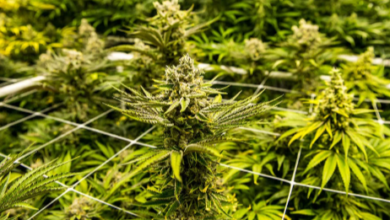How Do You Make Cbd Oil

The process of making CBD oil involves several critical steps that ensure both the quality and efficacy of the final product. It begins with selecting premium hemp strains, followed by determining the most suitable extraction method, such as supercritical CO2 or oil infusion. Each decision made during this process can significantly impact the oil’s potency and safety. Understanding these intricacies not only enhances the product’s effectiveness but also informs consumers about what to expect. As we explore the nuances of this production process, the implications for both personal use and market demand become increasingly clear.
Understanding CBD Oil
CBD oil, derived from the cannabis plant, is a concentrated extract that contains significant levels of cannabidiol (CBD), a non-psychoactive compound known for its potential therapeutic benefits.
Understanding CBD oil legality is essential for responsible use, as regulations vary by region.
Additionally, determining the appropriate CBD oil dosage is crucial to maximize its benefits while minimizing potential side effects, ensuring a safe experience for users.
See also: Is Sugar a Compound
Ingredients Needed
To create a high-quality CBD oil, one must gather essential ingredients, including a carrier oil, high-CBD hemp flower or extract, and optional additives for flavor or enhanced effects.
Proper ingredient sourcing is crucial for maximizing CBD oil benefits, ensuring purity and potency.
Select organic, sustainably sourced materials to enhance the overall quality of your oil, aligning with a commitment to health and wellness.
Choosing the Right Hemp
Selecting the appropriate hemp strain is crucial for optimizing the cannabinoid profile and ensuring the desired therapeutic effects in CBD oil.
Additionally, prioritizing organic certification is essential to avoid contaminants and ensure compliance with regulatory standards, ultimately enhancing the quality of the final product.
Understanding these factors will significantly influence the efficacy and safety of the CBD oil produced.
Hemp Strain Selection
Choosing the right hemp strain is crucial for producing high-quality CBD oil, as various strains exhibit distinct cannabinoid profiles and terpene compositions that significantly influence the final product’s efficacy and flavor.
Understanding hemp strain characteristics allows producers to select strains that maximize therapeutic benefits, ensuring consumers receive a product tailored to their needs while promoting the natural freedom of choice in wellness.
Organic Certification Importance
The significance of organic certification in hemp cultivation cannot be overstated, as it ensures that the plants are grown without synthetic pesticides, herbicides, or fertilizers, thereby enhancing the purity and safety of the resulting CBD oil.
Organic farming practices, coupled with a rigorous certification process, promote sustainability and consumer trust.
This empowers individuals to make informed choices about the products they use for their health and well-being.
Extraction Methods
Various extraction methods are employed to isolate CBD from hemp or cannabis plants, each with distinct advantages and considerations that influence the quality and efficacy of the final oil product.
Key aspects include solvent selection, where safe, food-grade solvents are preferred, and temperature control, which is crucial for preserving cannabinoid integrity and maximizing yield.
These factors directly affect the oil’s therapeutic potential and consumer safety.
Step-by-Step Process
The step-by-step process of making CBD oil requires careful consideration of several critical factors, starting with the selection of high-quality hemp.
An overview of extraction methods is essential to ensure the efficient and effective retrieval of cannabinoids, while proper storage techniques are crucial for maintaining the oil’s potency and extending its shelf life.
Understanding these components will provide a comprehensive framework for producing high-quality CBD oil.
Choosing High-Quality Hemp
Selecting high-quality hemp is crucial for producing effective CBD oil, as the plant’s genetics, cultivation methods, and harvesting practices significantly influence the final product’s potency and purity.
Focus on hemp sourcing from reputable farms that prioritize organic practices and adhere to rigorous quality assurance protocols.
Analyzing cannabinoid profiles and testing for contaminants further ensures the integrity of the hemp used in oil production, enhancing overall efficacy.
Extraction Methods Overview
After ensuring the use of high-quality hemp, understanding the different extraction methods is key to effectively isolating CBD and other beneficial compounds from the plant material.
The two primary methods are supercritical CO2 extraction, which utilizes pressurized carbon dioxide to extract cannabinoids efficiently, and solvent extraction, which employs solvents like ethanol to dissolve and separate the desired compounds.
Each method has its advantages, influencing purity and potency.
Storage and Shelf Life
Proper storage techniques are essential to maintaining the potency and efficacy of CBD oil, as exposure to light, heat, and air can lead to degradation of cannabinoids over time.
To ensure optimal conditions, store CBD oil in a cool, dark place, preferably in a sealed, opaque container.
Longevity tips include avoiding direct sunlight and refrigeration, which can alter its consistency and effectiveness.
Decarboxylation Explained
Decarboxylation is a crucial chemical process that transforms inactive cannabinoids, such as THCA and CBDA, into their active forms, THC and CBD, through the application of heat.
The importance of decarboxylation cannot be overstated, as it enhances the therapeutic potential of cannabis extracts.
Understanding the decarboxylation process is essential for anyone seeking to maximize the efficacy of their CBD oil.
Infusion Techniques
Infusion techniques are critical in the extraction of CBD oil, each offering distinct advantages and methodologies.
The Oil Infusion Method utilizes lipids to extract cannabinoids, while the Alcohol Extraction Process employs ethanol for a more potent yield.
Additionally, the Cold Press Technique is a mechanical method that preserves the integrity of the plant’s compounds, making it an alternative worth considering.
Oil Infusion Method
The oil infusion method is a widely recognized technique for extracting cannabinoids from plant material, utilizing carrier oils to create a potent and versatile CBD oil product.
By carefully controlling the infusion temperature and duration, one can optimize cannabinoid extraction while preserving the oil’s therapeutic properties.
This method allows for tailored potency, making it an attractive option for those seeking freedom in their wellness choices.
Alcohol Extraction Process
Utilizing a solvent-based approach, the alcohol extraction process effectively separates cannabinoids and terpenes from cannabis plant material, resulting in a concentrated CBD oil rich in therapeutic compounds.
This method offers alcohol benefits, such as enhanced extraction efficiency and purity.
However, safety considerations must be addressed, including the potential for flammability and the need for proper ventilation during the extraction process to ensure user safety.
Cold Press Technique
Cold pressing represents a method of extracting CBD oil that preserves the integrity of the plant’s beneficial compounds by mechanically pressing the cannabis material without the use of heat or solvents.
This technique offers significant cold press benefits, including enhanced flavor and nutrient retention.
Utilizing specialized cold press equipment, producers can maintain the natural profile of cannabinoids, ensuring a pure and potent final product.
Storing Your CBD Oil
Proper storage of your CBD oil is crucial to maintaining its potency and preventing degradation over time.
Utilize dark, glass containers to shield oil from light exposure and ensure a cool environment, ideally between 60-70°F.
Implement temperature control measures, as fluctuations can impact quality.
Following these cooking tips will help preserve your CBD oil’s efficacy, ensuring a premium product for your use.
Testing for Quality
To ensure the highest quality of CBD oil, it is essential to conduct thorough testing for potency, purity, and the presence of contaminants.
Rigorous lab testing, including potency analysis and contaminant screening, upholds safety standards and enhances quality assurance.
Certification processes and accurate product labeling are vital for consumer education, empowering individuals to make informed choices regarding their CBD oil products.
Potential Uses and Benefits
Numerous studies suggest that CBD oil may offer a range of therapeutic benefits, including alleviating anxiety, reducing inflammation, and managing chronic pain, thereby making it a compelling option for individuals seeking alternative health solutions.
However, adhering to dosage guidelines is crucial, alongside understanding legal considerations and potential side effects.
Increased consumer awareness and positive user testimonials reflect evolving market trends and growing recognition of CBD’s health benefits.
Conclusion
The meticulous process of crafting CBD oil resembles a delicate dance between nature and science, where high-quality hemp serves as the raw material and extraction techniques act as the conductor.
Each step, from decarboxylation to storage, ensures that the vibrant essence of cannabinoids is preserved, akin to capturing sunlight in a bottle.
Rigorous testing acts as the final guardian, ensuring purity and potency.
Ultimately, the creation of CBD oil is a harmonious blend of art and precision, unlocking potential therapeutic benefits.




